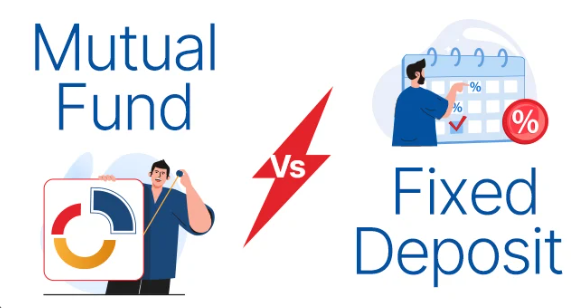When deciding between a fixed deposit (FD) and a mutual fund for investment, it’s essential to consider several factors including risk tolerance, investment goals, time horizon, and expected returns. Here is a comparison of the two options:
Fixed Deposit (FD)
Definition: A fixed deposit is a financial instrument provided by banks or non-banking financial companies (NBFCs) that offers investors a higher rate of interest than a regular savings account, until the given maturity date.
Key Features:
- Safety: FDs are considered one of the safest investment options since they are not market-linked.
- Returns: The interest rate is fixed and guaranteed. Typical returns range from 3% to 7% annually, depending on the tenure and the institution.
- Tenure: Flexible tenures ranging from 7 days to 10 years.
- Liquidity: Premature withdrawal is possible but usually involves a penalty.
- Taxation: Interest earned on FDs is taxable as per the investor’s income tax slab.
Mutual Funds
Definition: A mutual fund is an investment vehicle that pools money from many investors to purchase securities like stocks, bonds, and other assets.
Key Features:
- Risk and Return: Returns are market-linked and can vary. Equity mutual funds typically offer higher returns (potentially 10% to 15% or more annually) but come with higher risk. Debt mutual funds are relatively safer with moderate returns (around 6% to 9%).
- Diversification: Mutual funds provide diversification by investing in a variety of assets, which can mitigate risk.
- Liquidity: Mutual funds offer high liquidity, as units can be bought and sold at any time. However, some funds may have exit loads if redeemed within a certain period.
- Taxation: Equity mutual funds held for more than one year are subject to Long-Term Capital Gains Tax (LTCG) of 10% on gains above ₹1 lakh. Short-term capital gains (held for less than one year) are taxed at 15%. Debt mutual funds have different tax implications based on the holding period.
Comparison Table
| Feature | Fixed Deposit (FD) | Mutual Funds |
|---|---|---|
| Risk | Low | Varies (High for equity, low to moderate for debt) |
| Returns | Fixed (3% to 7%) | Variable (6% to 15% or more) |
| Liquidity | Moderate (penalty on premature withdrawal) | High (subject to exit loads in some cases) |
| Taxation | Taxable as per income slab | Varies: LTCG and STCG tax implications |
| Investment Tenure | Flexible (7 days to 10 years) | Flexible (can be tailored to goals) |
| Safety | High (principal guaranteed) | Varies (depends on the type of mutual fund) |
| Suitable for | Risk-averse investors | Investors with varied risk appetites |
When to Choose What?
- Fixed Deposits:
- Suitable for conservative investors who prioritize capital protection.
- Ideal for short to medium-term financial goals.
- Suitable for those who need a predictable income from interest.
- Mutual Funds:
- Suitable for investors willing to take on some risk for potentially higher returns.
- Ideal for medium to long-term financial goals, such as retirement or children’s education.
- Suitable for those who want to diversify their investment portfolio.
Ultimately, the choice between a fixed deposit and mutual fund should align with your financial goals, risk tolerance, and investment horizon. It can also be beneficial to have a mix of both in your investment portfolio to balance risk and returns.











